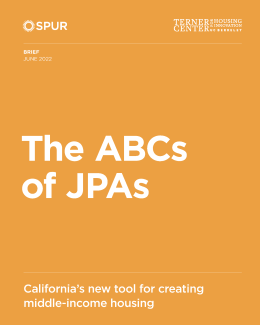With housing prices out of reach for many, California is facing the need to find new ways to create housing affordable to middle-income households. While there are housing subsidy programs for low-income households, very few tools exist to close the gap for middle-income households, those who earn between 80% and 120% of the area median income. A promising new model — joint powers authority (JPA) owned middle-income housing — allows cities and state-established financing authorities to act jointly to issue bonds and hold property. Housing projects developed under this model receive tax benefits, eliminating the need for direct public funding. To date this model has only been used to acquire existing buildings, but some developers are currently planning to use it to build new middle-income units.
Some cities and stakeholders have raised concerns about the JPA model. Balancing its benefits with the downside risks is important to ensuring that the model contributes to alleviating the state’s affordable housing shortage. This brief, co-authored by SPUR and the Terner Center for Housing Innovation at UC Berkeley, explains how the JPA model works, how it’s being used to produce affordable middle-income units and how to ensure that it delivers meaningful public benefits.
The Terner Center has also produced a report that explores the rising housing cost burdens facing middle-income households. The Landscape of Middle-Income Housing Affordability in California identifies policy opportunities for state and local governments to encourage the production of middle-income housing in California by relying on land use, building code and regulatory reforms.
Read the SPUR / Terner Center brief on middle-income housing JPAs
Read the Terner Center report on middle-income housing production
